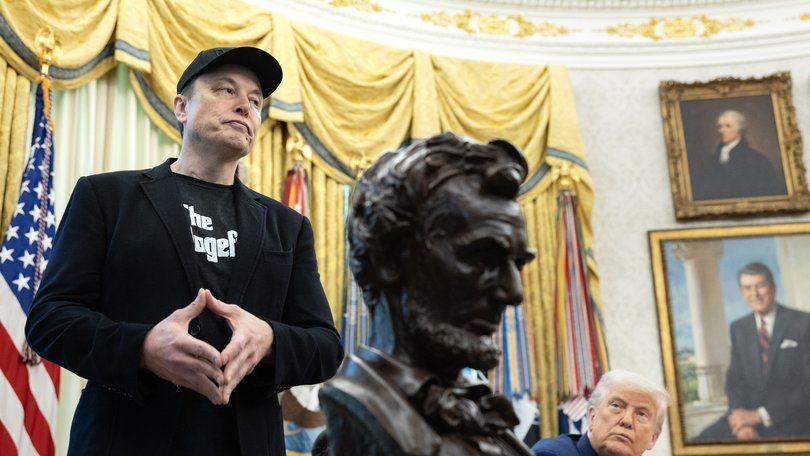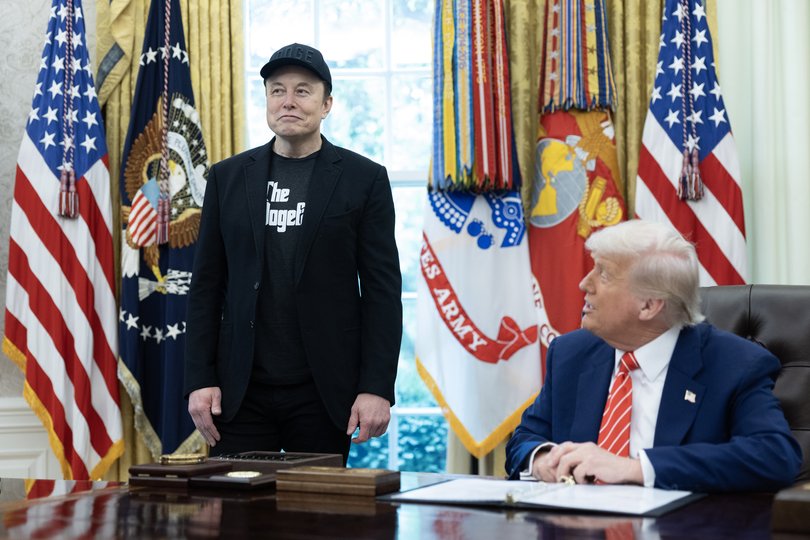Chainsaws and chaos: Inside Elon Musk’s failed crusade to fix Washington

Elon Musk said Friday that he is mostly done with Washington, but he leaves behind unfinished business, considerable damage and lowered expectations for his US DOGE Service.
He and the cost-cutting initiative are a metaphor for the first months of President Donald Trump’s second term: big promises, lots of drama, disruption, mistakes, directional shifts and business far from finished.
The DOGE example applies to other aspects of Mr Trump’s agenda, such as his tariff policy, which has investors’ heads spinning and other countries perplexed to dismayed, and his deportation initiative, which has run into legal roadblocks and damaged the lives of some individuals while still falling far short of the numbers his top advisers have promised.
Sign up to The Nightly's newsletters.
Get the first look at the digital newspaper, curated daily stories and breaking headlines delivered to your inbox.
By continuing you agree to our Terms and Privacy Policy.The same holds for Mr Trump’s unsuccessful efforts to bring Russia to the bargaining table to end the war in Ukraine, which now seems beyond the commitment of a president who once said he could broker an agreement in a matter of days.
Mr Trump is known for grandiose rhetoric, as befits a flamboyant real estate developer, but not a president.
He promises quick fixes to intractable problems, idealised outcomes, and a new “Golden Age” that do not materialise. He once said he could quickly balance the federal budget.
His spending and tax cut package, which is on a bumpy ride through Congress, would add trillions of dollars to the national debt.

Mr Musk, the world’s richest man, followed the leader. The DOGE - or the Department of Government Efficiency - initiative began as a centrepiece of the administration’s plan to bring the executive branch to heel, to remake a bureaucracy that Mr Trump and his allies perceived as part of a “deep state” resistance.
It was about cost savings but also about power and control. It has produced some savings, but the disruption of agencies shuttered, workers dismissed, and aid to vulnerable populations abroad cancelled has been significant.
The jury is still out on whether the overall project, which continues in Mr Musk’s absence, will make the country better.
Mr Musk’s business successes have been impressive.
Perhaps that persuaded him that it would be easy to redesign federal agencies and save bundles of money in the process. Governments often overregulate and spend wastefully.
The idea of renewal and reform is worthy; it should be a part of any administration’s toolkit. So he plunged ahead with a team of young loyalists.
But changing this culture requires knowledge, patience and a realistic sense of what is achievable.
Others who have been part of previous efforts to make government more efficient and less costly knew better than Mr Musk the difficulties he faced and said so. Mr Musk ignored what others were saying. A chainsaw became the symbol of his approach.
He originally claimed he could find $US2 trillion ($A3 trillion) in spending cuts on a budget of about $7 trillion. Experts scoffed.
When reality began to set in, Mr Musk scaled back that goal to $1 trillion.
As he returns his focus to repairing his private businesses (Tesla stock has dropped this year, as have vehicle deliveries, and SpaceX has suffered rocket losses in recent launches), the record shows that he has come nowhere close even to that revised number.
The DOGE website claims savings of $175 billion, which is more than Mr Musk’s recently stated $150 billion target.
That amount is not nothing, but it’s a fraction of what Mr Musk claimed. Tracking actual savings produced by DOGE has been a full-time effort for journalists and analysts. Claimed savings were often inflated, difficult to confirm or simply inaccurate.
Contracts that DOGE claimed as savings were sometimes cancelled long ago. Others claimed as cancelled were later reinstated.
DOGE is just part of the broader pattern of the administration. Start with tariffs. The past week, the US Court of International Trade stopped the bulk of the tariffs Mr Trump had issued in April. The president had claimed the power to impose the tariffs under the 1977 International Emergency Economic Powers Act.
The trade court said he had exceeded his authority. An appellate court issued a stay of the trade court ruling, meaning the tariffs remain as the adjudication continues.
But the trade court has raised a significant roadblock.
Administration officials seethed over the trade court ruling, saying it was just the latest example of judicial overreach.
The conservative Wall Street Journal editorial page, no fan of Mr Trump’s tariffs, said of the court ruling: “This is an important moment for the rule of law as much as for the economy, proving again that America doesn’t have a king who can rule by decree.”
This was just the latest twist in the implementation of the president’s tariffs, whose purpose remains murky.
Are they designed primarily to alter the trade imbalance, to raise revenue, as bargaining chips to bring about better trade agreements, or to punish China?
Mr Trump threatens and then relents. He imposes tariffs and then pulls back. He bashes allies and adversaries and then plays nice. He doesn’t like to be reminded of his inconsistency.
Last week, he lashed out at a reporter who asked about a description of his tariff policy as “TACO,” as in “Trump always chickens out.”
The government’s efforts to deport immigrants living here illegally continue to frustrate senior administration officials. Last week, there was a shake-up in the top ranks of Immigration and Customs Enforcement.
It came as White House Deputy Chief of Staff Stephen Miller, the architect of the administration’s immigration policy, renewed pressure on immigration officials to step up the pace.
He said the White House wants ICE agents to arrest at least 3,000 immigrants daily.
That target is far higher than the one set in January and one that seems unobtainable, until substantially more resources are provided. That money is included in the budget bill, but even assuming the measure clears Congress this summer, making use of it will not happen instantly.
Of all the administration’s domestic initiatives, deporting criminal migrants has had the most support from the public, but opinion is divided because of the callousness with which the administration has acted on some high-profile cases and concerns that officials are ignoring the due process rights of those who are being deported.
The immigration issue has become a long-running legal fight. Mr Trump has won and lost in the courts, with much yet to be resolved. The Supreme Court will be the ultimate arbiter.
On Ukraine, the president has failed repeatedly to produce a ceasefire, let alone negotiations that would lead to an end to the war. He has bullied Ukraine while demanding little of Russian President Vladimir Putin. He has expressed frustration with Putin several times but has yet to hold him to account. He has threatened to walk away entirely at a time when Russia’s strikes on Ukraine have escalated. He has shown that his social media postings and his off-the-cuff utterings have almost no power to influence an outcome.
Mr Musk appeared in the Oval Office with Mr Trump on Friday, marking the end of his official government service.
There was no mention of Mr Musk’s criticism of the budget bill in Congress that is central to Mr Trump’s legislative agenda.
Mr Trump praised him, and Mr Musk said he was “really not leaving” and claimed he would remain a friend and adviser to the president. He said the DOGE effort will grow stronger over time and will produce significantly more savings by the time it ends, perhaps up to $1 trillion.
But he leaves as a symbol of an administration that has promised much and delivered far less.
Mr Trump’s defenders say he has moved boldly. Others see recklessness and insensitivity instead, with disruption prized even in the absence of clear successes.
